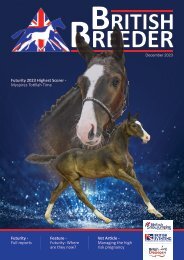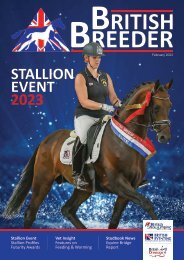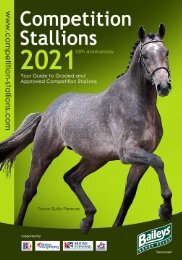British Breeder May 2023
The British Breeder is the magazine for all those interested and breeding sports horses. The latest news for the British Studbooks alongside features on dam lines, stallions, veterinary articles, nutrition, farrier and anything related to the breeding of sports horses.
The British Breeder is the magazine for all those interested and breeding sports horses. The latest news for the British Studbooks alongside features on dam lines, stallions, veterinary articles, nutrition, farrier and anything related to the breeding of sports horses.
You also want an ePaper? Increase the reach of your titles
YUMPU automatically turns print PDFs into web optimized ePapers that Google loves.
Feed Article - Dodson & Horrell<br />
Alongside suitable energy and protein<br />
sources, research indicates that<br />
colostrum and milk quality can be<br />
supported with additional<br />
supplementation. Some studies have<br />
examined the effect of vitamin and<br />
mineral supplementation of pregnant<br />
mares on the passive transfer of<br />
immunoglobulins to neonatal foals, with<br />
immunoglobulin G (IgG) used as an<br />
indicator of passive immunity gained<br />
from colostrum. Vitamin E is an<br />
essential nutrient in support of the horse’s<br />
immune system and is readily used within<br />
breeding nutrition. Inadequate intake<br />
during pregnancy and lactation can<br />
have a direct effect, causing deficiency<br />
in her foal from birth to one month of<br />
age1. Studies have shown that<br />
vitamin E supplementation supports an<br />
increase in colostral and serum IgG<br />
levels3, providing immune support for<br />
both mare and foal. Minerals that are<br />
vital for overall health include calcium<br />
and phosphorus. Calcium supports the<br />
skeletal system, and so during lactation<br />
there is an increased demand to ensure<br />
optimum growth and development of<br />
the suckling foal. The NRC4 states that<br />
calcium requirements for lactating mares<br />
increase by 1.8-2.8 times above a horse<br />
at maintenance, as well as phosphorus<br />
requirements increasing by 1.7-2.7 times<br />
maintenance. To ensure the correct<br />
calcium to phosphorus ratio of 2:1,<br />
choosing a specifically formulated feed,<br />
tailored to breeding, is recommended.<br />
is shown to be considerably higher in<br />
vitamin E than preserved forages, and so<br />
when less pasture is available,<br />
researchers recommend supplementing<br />
rations with vitamin E.<br />
Ensuring good quality colostrum and<br />
milk in broodmares can be daunting,<br />
with many factors to consider. The quality<br />
of the colostrum is vital for immunity of<br />
the foal, whilst milk quality is vital for<br />
postpartum growth and development.<br />
Appropriate, well-balanced nutrition<br />
of the broodmare that meets nutrient<br />
demand is therefore important<br />
throughout gestation and lactation.<br />
Research indicates that supplementing<br />
the mare with specific ingredients can<br />
have a positive effect on the foal’s<br />
intestinal health and absorption of<br />
essential nutrients2. Selecting<br />
scientifically formulated feeds<br />
specifically tailored to the requirements<br />
of breeding stock is the simplest way of<br />
ensuring your foals have the best start<br />
in life.<br />
In addition to this, supplementing mares<br />
with Saccharomyces Cerevisiae (yeast)<br />
were shown to result in higher IgG<br />
concentrations in foal serum, which<br />
indicated that foals had improved<br />
intestinal health and therefore, improved<br />
absorption2. The intestinal microbiota in<br />
early life stages can impact metabolic<br />
health, growth, and behaviour. The foal’s<br />
microbiome is shown to influence the<br />
risk of resistance to internal parasites,<br />
metabolic syndrome and colic<br />
throughout their life5. There is also<br />
evidence to show that colostral IgG<br />
concentrations were increased in mares<br />
that were supplemented with<br />
beta-glucans for the final month of<br />
gestation2.<br />
Pasture is considered to be the most<br />
desired source of forage for pregnant<br />
and lactating mares. It provides an<br />
improved source of energy, protein,<br />
vitamins and minerals in comparison to<br />
preserved forages such as hay. Although<br />
it is a great source of nutrients in support<br />
of broodmare health and milk quality,<br />
pasture may not be available. During<br />
the winter months grazing is sparse and<br />
nutrient concentrations are low,<br />
meaning they are consuming more<br />
preserved hay and less pasture. Pasture<br />
References<br />
1. Lawrence, L.M. (2013). Feeding Stallions and Broodmares. In: Geor. R.J, Harris. P.A,<br />
Coenen. M (Eds). Equine Applied and Clinical Nutrition. Amsterdam: pp. 236-240.<br />
2. Sobral, G.G., Gomes-Neto, O.C., & Carneiro, G.F. (2022). Effect of<br />
Supplementation with Saccharomyces Cerevisiae and glucans to Mares During Late<br />
Gestation on Colostrum and Passive Transfer of Immunity in Foals. Journal of Equine<br />
Veterinary Science, 121 (November/December): 104-168.<br />
3. Davies-Morel, M. (2021). Lactation. In: Davies-Morel. M (Ed). Equine Reproductive<br />
Physiology, Breeding and Stud Management: Fifth Edition. United Kingdom:<br />
pp. 86-94.<br />
4. National Research Council. (2007). Tables: Nutrient Requirement Tables. In:<br />
National Research Council (Eds). Nutrient Requirements of Horses: Sixth Revised<br />
Edition. Washington, DC. pp. 298.<br />
5. Robles, M., Hammer, C., Staniar, B., & Chavatte-Palmer, P. (2021). Nutrition of<br />
Broodmares. Veterinary Clinics: Equine Practice, 37: 177-205.<br />
Dodson & Horrell Ltd<br />
Aston Mill, Wrenbury Road, Aston<br />
Nantwich, Cheshire, CW5 8DH<br />
United Kingdom<br />
Tel: 01270 782 236<br />
enquiries@dodsonandhorrell.com<br />
www.dodsonandhorrell.com<br />
BRITISH BREEDER| 39







